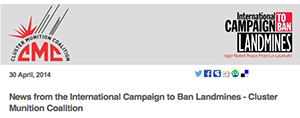08 August 2008
Japan: Cluster Bomb Ban To Force Defense Overhaul
(August 6, 2008) - The Defense Ministry has announced it will destroy the Self-Defense Forces’ stockpile of cluster munitions, a move that has shocked many senior officers and will force significant revisions to national defense policy.The decision came after the government in May joined an international treaty to ban the weapons, many of which remain unexploded in former conflict zones and pose a serious threat to civilians in those areas.An air-dropped cluster bomb or ground-launched cluster warhead scatters a series of smaller submunitions, or bomblets, over a wide area. The intention is to cause indiscriminate damage to enemy soldiers and armored vehicles.At least 75 nations possess cluster munitions. Fourteen have used them in military operations.According to a European nongovernmental organization, about 13,000 civilians, often children, around the world have been killed or maimed by submunitions that exploded long after the conflict had ended.The Convention on Cluster Munitions was adopted by about 100 nations, including Japan, on May 30 at a meeting in Dublin. It will be signed at a ceremony in Oslo in December.The accord bans the use, development, production, acquisition, stockpiling, and export and import of cluster munitions under any circumstances.It requires signatory nations to ensure the destruction of all banned munitions as soon as possible, but no later than eight years after the convention comes into force. But it allows signatory nations to engage in military cooperation and operations with nations not party to the convention.The Air and Ground SDF possess four types of cluster munitions, all of which are now banned.The ASDF has CBU-87/B cluster bombs, each of which contains 202 submunitions.The GSDF holds three types of cluster munitions for use, in M26 rockets, 155-millimeter howitzers and 70-mm anti-tank rockets. The M26 rocket launched from the M270 MLRS (Multiple Launch Rocket System) releases 644 submunitions.Although the government has not revealed the exact number of munitions stockpiled, the ASDF and the GSDF have spent a combined 27.5 billion yen to procure cluster munitions since the 1980s.The SDF introduced the munitions in the 1980s during the Cold War, citing their effectiveness in defending the island nation against invasion. The weapons would help the SDF, with its limited manpower and military capability, subdue enemy troops deployed over a wide area.For this reason, the government was initially reluctant to approve the convention, saying that it possessed the munitions exclusively for defense purposes.But Motoko Mekata, a professor at Chuo University and member of the steering committee of the Japan Campaign to Ban Landmines, dismisses this argument, saying cluster munitions are regarded as offensive weapons by the international community.The defensive role of such weapons in Japan has further been diminished since the government adopted a revised 10-year National Defense Program Outline in December 2004, under which it shifted focus to threats of small-scale terrorist and guerrilla attacks, on the grounds that a full-scale invasion by enemy military forces was now unlikely.Joining the international treaty will require significant revisions, however, as the revised outline allows the GSDF to deploy about 100 MLRSs at five locations in Hokkaido, Tohoku and Kyushu, while the ASDF can use cluster bombs to attack landing boats and other vessels offshore, and enemy troops onshore.The Defense Ministry is now deciding how to dispose of the cluster munitions, either by dismantling them to remove the explosives, or detonating them. It estimates that the disposal work will cost about 20 billion yen.Senior ASDF and GSDF officers said they were shocked by the government’s decision to sign the treaty.The forces are now seeking weapons capable of striking targets across a wide area, for fear the ban will leave them unable to defend broad coastal areas during an attack.A conventional artillery shell fired from the GSDF’s 203-mm self-propelled howitzer–which fires at a rate of just six shells a minute–can demolish an area with a diameter of 50 meters.The howitzer’s offensive capability is one-30th of the MLRS, which can launch 12 cluster-warhead rockets in a minute. And a CBU-87/B cluster bomb covers an area of 200 meters by 400 meters, or 160 times larger than a regular bomb.The Defense Ministry is considering introducing new cluster munitions developed by France and Germany that are not banned under the convention, which stipulates that a weapon will be exempted if: Each munition contains fewer than 10 explosive submunitions; each submunition is designed to detect and engage a single target; and each submunition is equipped with an electronic self-destruction mechanism.But Mekata, the Chuo University professor, remains skeptical about the Defense Ministry’s stance."(Such) low-precision munitions are outdated when many weapons are now capable of pinpointing their targets," she said.(IHT/Asahi: August 6,2008)


